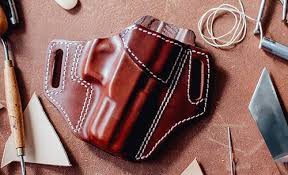
Therefore, one can hardly dream of a more fascinating and thoroughly engaging experience than starting the holster company on one’s own. As consumers are becoming more discerning with their choices, there is a good chance for new entrants to pick a specialized market in this industry. If you are a gun accessory enthusiast or if you want to be in business with countless imaginative and utilitarian opportunities, here are the ways to start your leather holster firm.
1. Research the Market
Begin by conducting thorough market research to understand the industry landscape:
Identify Your Target Audience: Decide what segment of the market will you serve, police and military or hunters and sports shooters or average Joe’s who want protection.
Analyze Competitors: Find out more about other successful holster companies to compare with them and notice gaps and opportunities.
Determine Trends: Some ideas to search are the latest trends such as concealed carry holsters, biodegradable and recycled products, or unique shapes.
2. Develop a Business Plan
A very thorough business plan is the structure upon which your entire company is started and built on. It should include:
Mission Statement: Summarize the aims and objectives of your company.
Product Line: Determine whether your store will focus on different kinds of holsters you’ll sell these holsters – the shoulder holsters, ankle holsters, or the custom-fit holsters.
Budget and Funding: Calculate your initial expense and consider, how you will finance your project: through a credit or an investor or your own capital.
Marketing Strategy: Firstly, contemplate how you’ll market your holsters using the internet platforms, trade shows or partnerships.
3. Choose Your Holsters, Build Your Models
Creating high-quality, functional designs is crucial for success:
Materials Selection: When deciding on the choice of materials it is preferable something long lasting yet light such as leather, Kydex or nylon.
Ergonomic Design: Paying attention to comfort, usability and safety all at the same time.
Prototyping: Create mock-ups as you do not want to expose your ideas on the big stage yet – you need to make necessary improvements first.
4. Set Up Manufacturing
Decide whether to produce holsters in-house or outsource production:
In-House Production: Some of the receivables include buying machines such as sewing machines, molds, and laser cutters.
Outsourcing: Source high-quality materials from credible manufacturers to act on your designs.
Quality Control: You should hire quality control personnel so that your end products are of high quality as those of a higher league.
5. Register Your Business
Legalize your business to operate professionally:
Choose a Business Name: Choose a recognizable name that would be easy for people to remember for your brand.
Register Your Company: Fill all the legal formalities that are needed for the registration of your business with the local and federal government.
Obtain Licenses: Ensure that any license or permit that may be necessary in producing and selling of the firearm accessories is secured.
6. Build an Online Presence
A strong online presence is essential to reach your target audience:
Website Creation: Create a corporate website with the catalog of products, safe payment methods, and customer service.
Social Media Marketing: Share portfolio on Instagram, Facebook, and YouTube consider being its main platforms.
SEO and Content Marketing: Working on promotion, it is necessary to think about seo for a website and blogging or vlogging.
7. Getting Your Business up and Running and letting the World know about It
Generate buzz and attract customers during your launch:
Promotional Offers: Provide discounts or free sample to the early buyers.
Collaborations: Promote your products through shooting ranges, firearm trainers or influencers with good followership.
Trade Shows: Go to the events related to particular industry so that you can introduce the target market to your holsters.
8. Deliver Outstanding Customer Service
Building a loyal customer base is vital for long-term success:
Feedback Mechanisms: Customers should be motivated to contribute their experiences and or give their opinions.
Responsive Support: Always, answer queries and concerns effectively.
Warranty and Repairs: Plead warranty and repair services, they help to gain a level of confidence.
9. Expand Your Product Line
As your business grows, consider diversifying your offerings:
Custom Holsters: Specialized designs for special needs.
Accessories: Complement your product with others such as belts, custom leather holsters, magazines or cleaning kits.
Innovations: Innovation is key, try out new materials, new designs or try out new technology to beat the competition.
10. Monitor and Adapt
Continuously assess your business performance and adapt to changing trends:
Track Sales and Metrics: This is because there is need to track performance against the set performance metrics so as to establish the strengths and weaknesses of the business.
Stay Updated: Contain with market changes and customers’ demand.
Adjust Strategies: Alter your advertising strategy, a product format, or a pricing scheme depending on the feedback you receive or the results of market research.
Conclusion
Writing a business proposal for a holster company needs passion, ideas, and strategizing. To achieve quality, innovation, and customer satisfaction, it is possible to create a strong business and capture a segment of the market of firearm accessories. Don’t let your dreams remain as such anymore, start and make your dream a reality today.